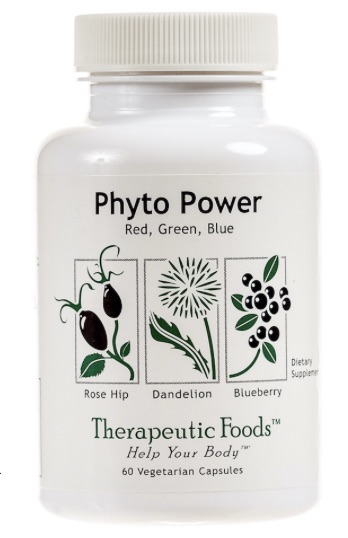Phenols and Oncogenes
Dear Friends
Phyto Power: Supports DNA and cellular integrity during oncogenic treatment due to
its potent antioxidant, anti-inflammatory, and antimicrobial properties.
its potent antioxidant, anti-inflammatory, and antimicrobial properties.

Food Science
- DNA & Cellular Integrity: Blueberries, rose hip, and dandelion are shown in research to help maintain cellular integrity, suppressing or interfering with oncogenic transformation, bolstering antioxidant and anti-inflammatory defenses, and contributing significant re-generative health benefits to the brain and nervous system (Jedrejek et al., 2017; Jiménez et al., 2016; Skrovankova et al., 2015; Joseph et al., 2014; Liu et al., 2013; Andersson et al., 2012; Chatterjee et al., 2011; Adams et al., 2010).*
- Anti-Inflammation: García-Lafuente et al. (2009) conclude that flavonoids from berries and plants behave as anti-inflammatory agents in our body. Blueberries are rich with anthocyanins and a wide variety of phytochemicals that have been shown to effect neuro-regeneration in the brain (Albarracin et al., 2012).*
- Energy & Weight-Loss: Dandelion is shown to have a great antioxidant activity (Hu et al., 2003), exhibiting diverse biological activities that promote energy, weight loss, and reduced risk of metabolic syndrome (Jedrejek et al., 2017; González-Castejón et al., 2012; Jeon et al., 2008). The Rose hip has a rich phytochemical profile known for its antioxidant protection (Widen et al., 2012), supporting weight loss with a potential mechanism that decreases abdominal visceral fat (Nagatomo et al., 2015).*
Added Suggestion: Combine with the Original Synbiotic to bolster immune support. Add also the greenest food, Organic Chlorella, to support detox mechanism and immunity.
References
- Adams, L.S., Phung, S. Yee, N., Sheeram, N.P., Li, L., & Chen, S. (2010).Blueberry phytochemicals inhibit growth and metastatic potential of MDA-MB-231 breast cancer cells through modulation of the phosphatidylinositol 3-kinase pathway. Cancer Res, 70(9), 3594-605.DOI: 10.1158/0008-5472.CAN-09-3565
- Albarracin, S.L., Stab, B., Casas, Z., Sutachan, J.J., Samudio, I., Gonzalez, J….Barreto, G.E. (2012). Effects of natural antioxidants in neurodegenerative disease. Nutr Neurosci, 15, 1-9. DOI: 10.1179/1476830511Y.0000000028
- Andersson, U., Berger, K., Hogberg, A., Landin-Olsson, M., & Holm, C. (2012). Effects of rose hip intake on risk markers of type 2 diabetes and cardiovascular disease: a randomized, double-blind, cross-over investigation in obese persons. Eur J Clin Nutr, 66, 585-590. DOI: 10.1038/ejcn.2011.203
- Chatterjee, S.J., Ovadje, P. Mousa, M., Hamm, C., & Pandey, S. (2011). The efficacy of dandelion root extract in inducing apoptosis in drug-resistant human melanoma cells. Evid Based Complement Alternat Med, 129045.DOI: 10.1155/2011/129045
- Dinstel R.R., Cascio J., & Koukel S. (2013). The antioxidant level of Alaska’s wild berries: high, higher and highest. Int J Circumpolar Health, 72. DOI: 10.3402/ijch.v72i0.21188
- García-Lafuente, A., Guillamón, E., Villares, A., Rostagno, M.A., & Martínez, J.A. (2009). Flavonoids as antiinflammatory agents: implications in cancer and cardiovascular disease. Inflamm Res, 58, 537-552. DOI: 10.1007/s00011-009-0037-3
- Hu, C., & Kitts, D.D. (2003). Antioxidant, prooxidant, and cytotoxic activities of solvent-fractionated dandelion (Taraxacum officinale) flower extracts in vitro. Journal of Agricultural and Food Chemistry, 51, (1), 301-310.DOI: 10.1021/jf0258858
- Jeon, H.J., Kang, H. J., JungH.J. Kant, Y.S., Lim, C.J., Kim, Y.M., & Park, E.H. (2008). Anti-inflammatory activity of Taraxacum officinale. Journal of Ethnopharmacology, 115 (1), 82-88. DOI: 10.1016/j.jep.2007.09.006
- Jeyabalan, J., Aqil, F., Munagala, R., Annamalai, L., Vadhanam, M.V., Gupta, R.C. (2014). Chemopreventive and therapeutic activity of dietary blueberry against estrogen-mediated breast cancer.J. Agric. Food Chem, 62, 3963-3971. DOI: 10.1021/jf403734j
- Jiménez, S., Gascón, S., Luquin, A., Laguna, M., Ancin-Azpilicueta, C., Rodríguez-Yoldi, M.J. (2016). Rosa canina Extracts Have Antiproliferative and Antioxidant Effects on Caco-2 Human Colon Cancer. PLoS One, 11(7), e0159136. https://doi.org/10.1371/journal.pone.0159136
- Joseph, S.V., Edirisinghe, I., & Burton-Freeman, B.M. (2014). Berries: anti-inflammatory effects in humans. J Agric Food Chem, 7; 62(18), 3886-903. DOI:10.1021/jf4044056
- Liu, W., Lu, X., He, G., Gao, X., Xu, M., Zhang, J… Luo, C. (2013). Protective roles of Gadd45 and MDM2 in blueberry anthocyanins mediated DNA repair of fragmented and non-fragmented DNA damage in UV-irradiated HepG2 cells. Int Mol Sci, 14(11), 21447-62. DOI: 10.3390/ijms141121447
- Nagatomo, A., Nishida, N., Fukuhara, I., Noro, A., Kozai, Y., Sato, H., & Matsuura, Y. (2015). Daily intake of rosehip extract decreases abdominal visceral fat in preobese subjects: a randomized, double-blind, placebo-controlled clinical trial. Diabetes Metab Syndr Obes, 8, 147-156.DOI: 10.2147/DMSO.S78623
- Skrovankova, S., Sumczynski, D., Mlcek, J., Jurikova, T., Sochor, J.(2015). Bioactive Compounds and Antioxidant Activity in Different Types of Berries.Int J Mol Sci, 16(10), 24673-706. doi: 10.3390/ijms161024673
- Widen, C., Ekholm, A., Coleman, M.D., Renvert, S., Rumpunen, K. (2012). Erythrocyte antioxidant protection of rose hips (Rosa spp.) Oxid Med Cell Longev, 621579. http://dx.doi.org/10.1155/2012/621579 .
Sincerely yours,
Seann
We have developed our products based on scientific research and/or the practical experience of many healthcare practitioners. There is a growing body of literature on food based nutrition and supplements and their application in support of our health. Please use our products under the advisement of your doctor.
Green Facts:
 Phyto Power is indeed powerful. In fact, Dinstel et al. (2013) found the antioxidant levels of Alaska’s wild berries to be extremely high, ranging from 3 to 5 times higher in ORAC values than cultivated berries from 48 other states. For example, cultivated blueberries have an ORAC scale of 30. Alaska wild dwarf blueberries measure 85. When the berries were dehydrated, per gram the ORAC values increased.* Phyto Power is indeed powerful. In fact, Dinstel et al. (2013) found the antioxidant levels of Alaska’s wild berries to be extremely high, ranging from 3 to 5 times higher in ORAC values than cultivated berries from 48 other states. For example, cultivated blueberries have an ORAC scale of 30. Alaska wild dwarf blueberries measure 85. When the berries were dehydrated, per gram the ORAC values increased.* |
|
©2005 – 2018 BioImmersion Inc. All Rights Reserved
|